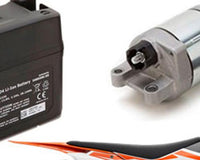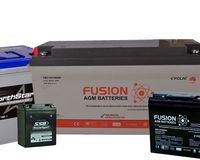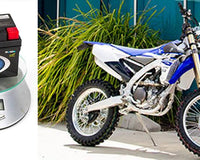Table of Contents
4x4 batteries are heavy duty and designed for added strength and endurance to power large 4WD vehicles, trucks and SUVs.
They can be grouped into three main categories:
- Starting batteries. Designed to kick and go under extreme conditions like harsh temperatures or bumpy outback roads.
- Dual-purpose (starting combined with semi-cycling). These pack enough power to start the engine in any conditions and carry enough cycling abilities to light up camping equipment and lights.
- Deep cycle. They have long cycles to give longer-lasting power to your camping accessories.
Here’s what you need to know.
Explaining the 4×4 Battery Chemistry
| Battery Chemistry | Variations | CCA | RC | Ah | Polarity | Terminal type |
| Lead-acid /Calcium | Sealed, Flooded, AGM and Gel | 650–735 | 110–180 | 65-95 | C, D | STD/WNUT |
| Lithium | Lithium phosphate | 720–815 | 160-185 | 85–95 | C, D |
STD |

Lead-Acid (Wet Lead Acid/Calcium) 4x4 Batteries
Lead-acid SUV batteries come in three main variations.
- Regular lead-acid which can either be sealed maintenance-free or flooded maintenance
- AGM
- Gel
The electrodes are lead or calcium lined vertically inside the battery. The metal plates are dipped inside the battery electrolyte made of acidified water (water mixed with sulphuric acid).
When the battery discharges, the sulphuric acid breaks down into positive hydrogen ions and negative sulphate ions. The ions move towards the negative and positive terminals, respectively, generating power in the process.
During the recharge phase, the sulphate separates into the original metal and sulphuric acid. As a result, more hydrogen and sulphate ions can be released for the cells to produce more power.
There are four main variations on the lead-acid 4x4 and SUV batteries.
- There's the flooded low maintenance type. With this one, you have to top-up the fluid at intervals during the life of the battery.
- Then comes maintenance-free or sealed batteries. These are sealed at the top, so you can't add more fluid when they get depleted.
- Also, there’s the Absorbed Glass Mat (AGM). Here the acidic electrolyte is held inside microfiber glass mats which are pressed against the battery plates. They are guaranteed against spills and leakages.
- The other non-leak lead-acid battery is called the gel battery. It’s very similar to the AGM, except the electrolyte comes in gel capsules made of silica.

4×4 Lithium Battery
Lithium 4x4 batteries derive power from lithium iron phosphate (LiFePO4) chemistry. LiFePO4 is the positive electrode and graphitic carbon on the negative.
Unlike the chemical reaction in the lead-acid cells, there is no chemical bonding of substances. Instead, lithium ions are released from the positive electrode and moved towards the negative side and, in the process, produce a current.
During the charging stage, lithium ions return to their original positive side and wait for the cell to start discharging again. The electrolyte remains untouched and acts mainly as a barrier to insulate the battery, which is why they have a longer cycle life.
Why Use 4x4 Batteries?
If you're one for outback rides or camping trips, the 4x4 battery is your best bet. Here are some reasons why:
Stronger Than a Regular Car Battery
4x4 batteries will last longer than regular ones during your off-road driving. Regular car batteries are designed for smooth driving and can’t withstand the pressure of continuous vibration and bumps from uneven terrain.
Can Tolerate High Temperatures
They are designed to withstand extreme heat; plus, when installing 4x4 batteries, they are enclosed in a polypropylene cover with an internal liquid that keeps it cooler for longer. The polypropylene SUV’s specialised plate design ensures that they deliver more power for longer.
Note: To ensure the batteries you get from the vehicle shop give you good value for money, only buy batteries designed and tested for the Australian weather.
High Capacity and Design for Remote Locations
4x4 batteries have a high inbuilt capacity with enough starting power to crank high compression engines into action. With a cold-cranking capacity at a minimum of 600, you can be assured that your battery will kick in regardless of the weather condition.
In addition, the SUV’s improved plate design allows you to use two batteries simultaneously— one to start the car and one to power your accessories.
For instance, you can have a starter and a deep cycle battery under the same bonnet. Having two means you can start your car at will and be sure to have cold beers in your bar fridge for the whole trip.
The deep cycle type can also act as a reserve power source should your starting one go flat.
Side Note: You can recharge your 4x4 battery on your outdoor trips with solar power. A simple installation of a reliable solar power system to the back of your truck will make it easy to charge on the go.
With a solar power system, your trips can be as long as you want with no stress of running out of juice for your lights or other equipment.
Take a look at our solar panel options and accessories. If you need to know more about using solar to power your heavy duty batteries get in touch with us.
Frequently Asked Question
What’s the most commonly asked question about 4x4 batteries?
How Can I Maintain My Battery?
Regularly clean and tighten the cable connections (remember to check the earth connection). Ensure you check the liquid electrolyte level at least twice a year. You can top up the fluid with distilled or battery water when you need to, up to the level indicated on the casing.
To stop the terminals from corroding, coat them with a terminal protection spray, grease or vaseline.
Getting the Right Battery for Your 4WD Vehicle
Choosing between lithium and lead-acid for your 4x4 is not a cut and dry decision. When comparing the main parameters, you will find that each has its pros and cons.
| Parameter | Lead-acid | Lithium |
| Charging | Takes more time Can be charged using the car’s alternator | Faster charging Needs a specialised charging system |
| Weight | Heavier | Lighter weight |
| Temperature adjustment | Withstands higher bonnet temperatures | Overheats more quickly |
| Cycle | Lower cycle life | Longer cycle life |
| Starting power | Higher starting power | Not for cranking |
More importantly, the best choice for you depends on factors like:
- The intensity of vibrations and temperatures in the areas you want to go.
- How much starting power your car needs
- The CCA, RC, AH dimensions and specifications of your car
- Your car’s compatible polarity terminal type
Buy your 4x4 batteries from the pros at HB Battery specialists. Give us some details about your trip and vehicle details, and we'll help you make an informed decision.
Get in touch with us today for all your 4x4 battery needs.
Went the extra mile - Great experience, friendly and helpful staff, made sure I got my battery when I needed it.
Philip C












